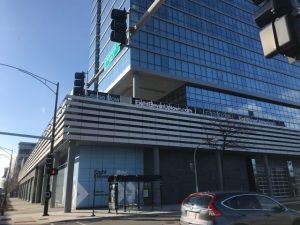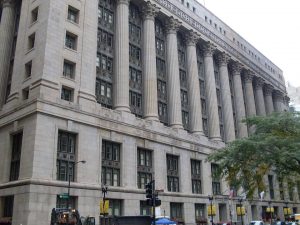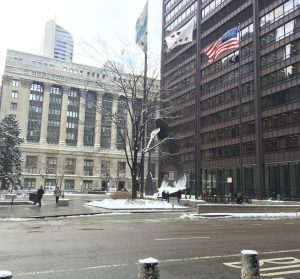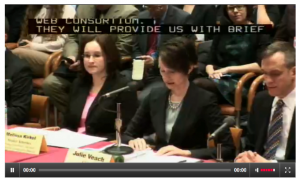By Curtis Black, Newstips Editor, Community Media Workshop
With neighborhood economic development groups objecting to a major reduction in city funding at a time of growing job loss, 22 aldermen have submitted a resolution ordering the Mayor’s Office of Budget and Management to restore the funds in the city’s proposed 2010 budget.
The resolution is on the agenda for the City Council’s budget committee hearing on Monday. If approved, it could be considered at Wednesday’s council meeting.
The proposed budget for the Department of Community Development cuts spending by 21.5 percent for delegate agencies – about 120 neighborhood chambers of commerce and other groups that support commercial and industrial districts.
It’s a huge cut for a small budget item – a $1.5 million reduction from last year’s appropriation of $6.4 million. It’s a far greater reduction than other programs in the department. And it comes on top of cuts ranging from 3 to 7.5 percent each of the past six years, while the city’s budget has steadily grown.
With pressure on neighborhood businesses ratcheting up, other funding sources for the groups – especially local banks and real estate agencies, who know the value of a thriving business district — have been squeezed particularly hard, said Kimberly Bares of the Rogers Park Business Alliance.
Because the city provides only partial funding, its spending on delegate agencies seeds a tremendous amount of economic development effort, she said.
“We’re providing tremendous value to the city’s efforts, for minimal funding,” said Roger Romanelli of the Randolph Fulton Market Assocation. “We’re out on the streets every day, working directly with hundreds of businesses” in ways that would be impossible for the city.
“Most delegate agencies have staffs of one or two people doing the work of ten,” said Luis Alva of the Little Village Chamber of Commerce. LVCC’s activities include workshops for businesses on a range of topics as well as a highly successful 13-session workshop on starting a business. “These are people who go on to open businesses, invest in the community, and hire people,” he said.
The group also features festivals and sales to attract shoppers from outside the community to the 26th Street retail district, which is second only the Michigan Avenue in business activity and sales tax revenue. Local dress shops are clamoring for a repeat of LVCC’s recent bridal expo, Alva said.
Delegate agencies include groups funded under the Local Industrial Retention Initiative (LIRI), which are also facing 21.5 percent cuts, said Mike Holzer of the Local Economic and Employment Development Council. LIRI is the city’s primary delivery vehicle for direct economic development services to small manufacturers, and LEED Council manages the North River Industrial Corridor.
LEED Council has leveraged over half a billion dollars in private investment for the corridor, which includes four planned manufacturing districts, Holzer said. The Goose Island district, which was a marginal industrial area in the early 1990s, when 25 firms employed fewer than 1,000 workers, is thriving today, with over 65 firms and a workforce of 5,000, he said.
Those are jobs that allow workers to buy homes and send children to college. And they’ve been attracted during a period when the U.S. has lost millions of manufacturing jobs; Chicago lost over 100,000 manufacturing jobs from 1995 to 2005, according to the Brookings Institute.
Small and mid-size firms generate the vast majority of new jobs, said Ellen Shepard of the Andersonville Chamber of Commerce, and since local businesses use local suppliers and support charities in their own communities, they generate far more local economic activity.
“With national and international markets faltering, and many residents being laid off…we are more reliant than ever on our neighborhood businesses,” she said. The city should be “significantly” boosting funding for neighborhood development groups, not cutting it, she said.
Bares said the cuts are likely to force some neighborhood groups to close down – and adds that there are local business support groups on the South and West Sides that have yet to be included in the city’s delegate agency program.
With major corporations getting city subsidies of tens of millions of dollars, while over a hundred local groups – which serve thousands of small businesses — must share a $5 million program, it’s clear the city could focus more on locally-owned businesses. The other program supporting neighborhood businesses, the Small Business Improvement Funds provided by selected TIF districts, is being cut this year from $3 million to $2.25 million.
That means less than half of 1 percent of TIF funds go to support small business, Shepard said. Romanelli said he had 38 applicants for small SBIF grants in the Kinzie Industrial TIF last year; funds were only available for eight grantees.
With aldermen now responding, cuts may be headed off this year – but it’s a bit of a fluke. Bares learned of the cuts ahead of time only because she serves on the city’s Community Development Advisory Committee; she went on to alert her colleagues. In previous years, delegate agencies learned their allocations were being cut only after the budget had been approved.
“This has certainly illustrated to us the difficulties everyday citizens have negotiating the city’s budget labyrinth,” she said.
















Be First to Comment